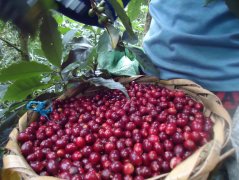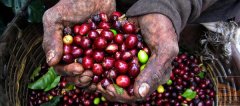The Origin and Development of Yejashefi Coffee Peasant Union (YCFCU) and Hofsha Cooperative treatment Plant

For professional baristas, please follow the coffee workshop (Wechat official account cafe_style)
Information introduction of Hofsha Harfusa Cooperative processing Plant
Hofsha was originally the name of a village in the town of Ethiopia. The Hofsa Cooperative was established as early as 1975 and can be said to be the vanguard of the first wave of cooperative movement in Ethiopia. There are currently about 843 members. On average, small farmers have 70% of the average cultivated area, while producers have 450 kilograms of exported coffee beans.
The source of coffee berries in the Hofsa cooperative processing plant is mainly from the hillside of the village of Hofsa and to the west of the plant, from about 1850 meters to a maximum of 2100 meters above sea level, and some from the hillside of the village of Konga in the south, where the elevation is from 1870 meters to 2000 meters above sea level. The locations of the two regional coffee plantations are excellent in terms of elevation and slope, and this has become the basic condition for cooperatives to produce excellent raw coffee beans.
Hofsa Cooperatives joined the Yega Sheffield small Farmers Cooperative Union (YCFCU, Yirgacheffe Coffee Farmers Cooperative Union) in 2013 and obtained "organic" and "fair trade" certification. The Hofsa Cooperative, in cooperation with local small farmers in Yejassefi, adopts shade planting techniques and intersperses with crops such as bananas, planting with full manual and organic fertilizers, and controlling diseases and insect pests in a natural way, so as to ensure ecological protection. make the taste of coffee more pure.

The Origin and Development of Yejashefi Coffee Peasant Union (YCFCU)
Founded in July 2002, YCFCU represents more than 43, 000 farmers and belongs to more than 300000 families. At present, 23 members of Hengzuo Society are located in Dedeo District, Nanfeng, Ethiopia. This is a place famous for producing coffee. Only coffee is grown on 62 hectares of farmland, and the cooperative produces an average of 9000 tons of washed coffee a year in Yejia Schiff and about 3000 tons in Sidamo. In addition, 24000 tons of sun-dried coffee beans are produced a year.
The traditional method of growing coffee in Ethiopia is widely spread among coffee farmers in Yejashev. Although the protection and handling of coffee are done in accordance with certain procedures, the use of organic and natural fertilizers is gradually developing. Pests are controlled through biological and natural methods. Under such circumstances, through the application of traditional methods, rather than the use of chemicals and chemical fertilizers to control diseases and insect pests, so as to make the development of the whole industry more complete.
[Ethiopian Water washed Yega Shiffi Hoffa Village G1] Coffee flavor description
Product name: Ethiopia Washed Yirgacheffe Harfusa G1
Production area: Yirgacheffe
Processing plant: Harfusa
Management: washing
Grade: G1
Flavor description: floral, orange, sugar water and other aromas, lemon, black tea, honey, cocoa.
Important Notice :
前街咖啡 FrontStreet Coffee has moved to new addredd:
FrontStreet Coffee Address: 315,Donghua East Road,GuangZhou
Tel:020 38364473
- Prev

The Origin of the Manor in the Village of Rosa in Ethiopia Gesha Rose Summer\ does Geisha really originate in the Village of Rose Xia
For the exchange of professional baristas, please follow the coffee workshop (Wechat official account cafe_style) Yega Xuefei producing area and flavor introduction in Ethiopian archaic, yirga means to settle down, cheffe is wetland, Yega Xuefi (Yirgacheffe)
- Next

A brief introduction to the producing area of Sidamo in Sidamo, Ethiopia and the advantages of high-shelf solarization in Africa
For the exchange of professional baristas, please follow the Coffee Workshop (official Wechat account cafe_style) A brief introduction to the Sidamo producing area of Sidamo Sidamo is located in the south of Ethiopian soil, with an elevation range of 1400m to 2200m, with distinct dry and wet seasons and double rainy seasons, so it can be harvested twice a year. Coffee is usually grown in this area, which belongs to small farmers, in their own countryside.
Related
- Detailed explanation of Jadeite planting Land in Panamanian Jadeite Manor introduction to the grading system of Jadeite competitive bidding, Red bid, Green bid and Rose Summer
- Story of Coffee planting in Brenka region of Costa Rica Stonehenge Manor anaerobic heavy honey treatment of flavor mouth
- What's on the barrel of Blue Mountain Coffee beans?
- Can American coffee also pull flowers? How to use hot American style to pull out a good-looking pattern?
- Can you make a cold extract with coffee beans? What is the right proportion for cold-extracted coffee formula?
- Indonesian PWN Gold Mandrine Coffee Origin Features Flavor How to Chong? Mandolin coffee is American.
- A brief introduction to the flavor characteristics of Brazilian yellow bourbon coffee beans
- What is the effect of different water quality on the flavor of cold-extracted coffee? What kind of water is best for brewing coffee?
- Why do you think of Rose Summer whenever you mention Panamanian coffee?
- Introduction to the characteristics of authentic blue mountain coffee bean producing areas? What is the CIB Coffee Authority in Jamaica?

